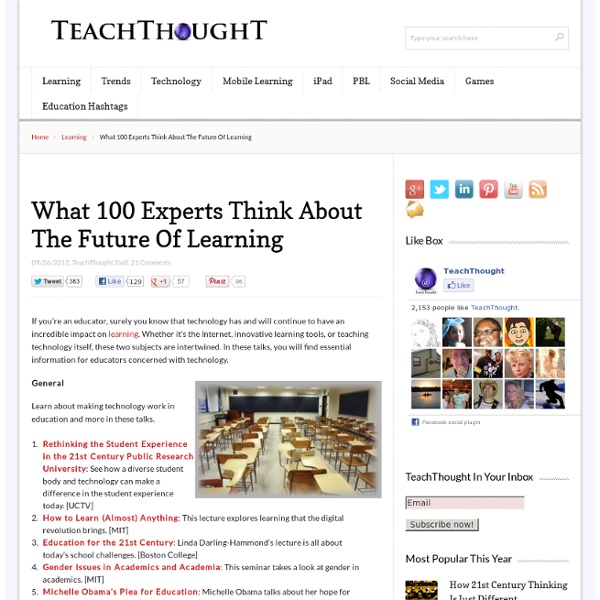The Difference Between Linear and Exponential Thinking
As humans we evolved on this planet over the last hundreds of thousands of years in an environment that I would call local and linear. It was a local and linear environment because the only things that affected you as you were growing up on the plains of Africa was what was in a day’s walk. It was local to you.
34 Remarkable and Surprising Things About The Future — Life Learning
34 Remarkable and Surprising Things About The Future I’ve been reading and thinking about the future a lot recently, and decided to spend a week “nerding out” at Singularity University, to satisfy my curiosity. It was a great event, featuring experts from across the entire spectrum of technology and innovation. In this post I’ll share the ideas I’ve been developing for some time — based on my own research as well as time at spent at SU — on how we should think about the future and the myriad opportunities it presents. I am extremely optimistic about our future being a world where powerful technologies solve some of our biggest challenges across a range of industries from medicine to transportation to energy and many others. This will result in a significantly better standard of living for all as well as many remarkable inventions, in the same way that we live significantly better and different lives than our great great grandparents did.
Is technology making us more or less intelligent?
Editor’s note: This article is part of our collaboration with Point Taken, a new program from WGBH that will next air on Tuesday, June 21 on PBS and online at pbs.org. The show features fact-based debate on major issues of the day, without the shouting. The smartphone in your hand enables you to record a video, edit it and send it around the world. With your phone, you can navigate in cities, buy a car, track your vital signs and accomplish thousands of other tasks. And so? Each of those activities used to demand learning specific skills and acquiring the necessary resources to do them.
In the future your sales assistant could be a robot
This fall, customers cruising the aisles of Lowe’s home improvement stores in the San Francisco Bay Area may see a new type of employee taking inventory and assisting shoppers. You won’t find a nametag on this worker, but you won’t confuse it with other employees, either. The new kid in town is the LoweBot, an autonomous retail service robot that scans and audits store inventory on the floor. It uses voice recognition to identify products for customers and lead them to the right shelf — in multiple languages. The retailer is deploying LoweBots at 11 of its Bay Area stores over a seven-month period using NAVii robots made by Fellow Robots, following a successful two-year pilot program of a first-generation robot called OSHbot that was tested at one of Lowe’s Orchard Supply Hardware stores.
Ces start-up qui veulent bidouiller le cerveau: les autres
Nous allons ici terminer cette petite série d’article sur le bidouillage du cerveau après avoir passé en revue les deux grandes start-up du domaine: Neuralink d’Elon Musk et OpnWatr de Mary Lou Jepsen. Ces deux sociétés bien visibles ne sont pas seules sur le créneau. Vous remarquerez que je ne traite dans cette série d’articles que les plus extrêmes des projets entrepreneuriaux ou de recherche. Je n’y creuse pas la quantité de sociétés qui conçoivent depuis plusieurs années des casques d’électro-encéphalogrammes (EEG) classiques et les applications logicielles qui vont avec pour mesurer notre stress, nous endormir avec de la musique, piloter des dispositifs de commande simples, ou autres solutions «light» du genre! Il s’agit par exemple des casques de Muse, Emotiv, Neurosky, Halo Neurosciences ou des Français Dreem et aussi de Mensia Tech qui développe des solutions pour l’hyperactivité enfantine avec une technologie issue de l’INRIA, du projet Brain Machine Interface. L’expert
Slack CEO: How We’ll Use AI to Reduce Information Overload - MIT Technology Review
More than six million people use Slack every day as a hub and platform for communicating and sharing information with their coworkers. The San Francisco–based company also just raised $250 million more in funding, in a round that puts its value at a lofty $5.1 billion (see “10 Breakthrough Technologies 2016: Slack”). But new competitors—among them Microsoft Teams, Atlassian Stride, Google Hangouts Chat, and Workplace by Facebook—are pushing into the workplace-collaboration market, challenging Slack’s dominance and, in some cases, specifically marketing themselves as more productive options. During a trip to Boston, Slack CEO Stewart Butterfield spoke to MIT Technology Review about the ways the company plans to use AI to keep people from feeling overwhelmed with data.



